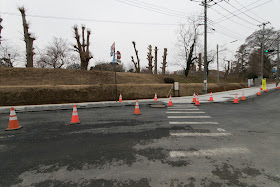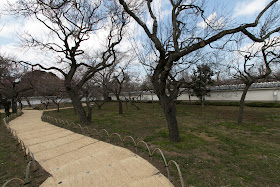Mito Castle
-Castle of three branch Tokugawa families closest to Edo-
Overview
Name: Mito castle (Mito-jo)
Alias: Suifu-jo
Place: Sanno-maru Mito city, Ibaraki
Location: 36.373077214306036, 140.48229673984142
Type: Hill castle
Built: Originally 12th century, expanded in 1580's
Remaining remnants: Gate, clay walls and dry moats
Title: 100 famous Japanese castles
Mito casle was originally built in 12th century by local lord Daijyo clan. Daijyo clan was a traditional clan stem from Taira clan, and governed Mito area since 12th century. In Muromachi era Daijo clan lost their power by being involved in the battle of governors of Kanto region. In 15th century, Edo clan expelled Daiyo clan and became the lord of this castle.
On the other hand, Satake clan which was a descendant of Minamoto clan governed north part of Hitachi country based on Hitachi Ota castle. Satake clan was appointed as a governor of Hitachi country by Muromachi Shogunate, but temporally lost their power due to an internal conflict in 15th century. But since the beginning of 16th century, Satake clan recovered its governance and turned to expansion.
Especially Yoshishige Satake (1547-1612) was famous as "Damon Yoshishige", fiercely fought with surrounding strong warlords such as Hojy clan of Sagami country (Kanagawa prefecture) or Ashina clan of Mutsu country (Fukushima prefecture), and grew Satake clan to the dominant power of Hitachi country. Around 1570, Edo clan virtually subordinated to Sagake clan but still had certain autonomy.
At the time of Odawara campaign made by central ruler Hideyoshi Toyotomi (1537-1598) against Hojyo clan in 1590, Satake clan participated in the army of Hideyoshi and was praised its continuous fight against Hojo clan, but Edo clan could not visit due to internal conflict.
Seeing this situation Hideyoshi approved Satake clan to seize whole Hitachi country, and in that year Yoshinobu attacked Edo clan and Daijo clan then seized most part of Hitachi country. Next year Yoshinobu premeditated small lords at south part of Hitachi country, and finally united the country.
As a large lord of Toyotomi government, Satake clan significantly expanded Mito castle. Originally the castle had only one area at the edge of the height, but Satake clan newly built huge secondary area and third area outside of central area and total length of the castle reached 1 kilometer.
Even though Mito castle did not have stone walls, but central area and secondary area was separated by huge dry moat of 20 meter width and depth, and suitable to the distinguish family of traditional eastern Samurai.
After the death of Hideyoshi of 1598, in 1600, the battle of Sekigahara occurred between Ieyasu Tokugawa (1543-1616), the largest lord under Toyotomi government and Mitsunari Ishida (1560-1600), former chief magistrate of Toyotomi government. Yoshinobu was close to Mitsunari but his territory was next to the territory of Tokugawa clan, thus Satake clan kept neutral and did not participate in the battle.
After the battle, Satake clan was not extinguished but transferred to Dewa country (Akita prefecture) with decreased territory and built Kubota castle. Edo Shogunate did not allow large lord to reside near Edo city, the main base of Shogunate.
Ieyasu had 11 sons, and he specially treated the youngest three sons as three special branch domains (called as "Shinpan") of Shogunate. These special domains were place at important places, it means Owari domain at Nagoya castle (Aichi prefecture), Kishu domain at Wakayama castle and Mito domain at Mito castle. These domains were expected to hold back the enemy as a core of local army until the reinforcement of Shogunate arrives. Additionally, if the main stream of Shogunate extincts, next Shogun were to be selected from these branch domains.
At first Ieyasu placed his sixth son Yorinobu Tokugawa (1602-1671) at Mito domain, but later changed to his last son Yorifusa Tokugawa (1603-1661). Mito domain was one of the highest rank domains under Edo Shogunate, but only had half territory compared with Owari domain or Kishu domain. As there was less possibility of actual attack, Mito castle was not reformed and stayed simple, except for a three story turret used as a substitute of main tower.
As Mito domain was close to Edo city, Mito domain deeply participated in the operation of Edo government. Second domain leader Mitsukuni Tokugawa (1628-1701) liked academy and edited "Dai Nihonshi" (history of Great Japan), whole history from ancient era to medieval era. Mitsukuni sent his retainers to many places to gather information, and this fact created the tale that Mitsukuni who called as "Mito Komon" wandered all over Japan with his guard Sukesan and Kakusan, then punished bad local magistrates.
At the middle of 19th century, domain leader Nariaki Tokugawa (1800-1860) processed the reform of the domain, and established domain school named Kodokan. Nariaki grew many talents and affected the policy of Edo Shogunate faced the pressure from foreign countries, but fell down after political conflict. Mito domain also suffered from severe internal conflict between reformists and conservatives, and could not contribute to Meiji revolution. Mito castle lost many buildings at the time of this conflict.
Subsequent to the Meiji revolution almost all buildings were lost, and remaining three story turret was burnt down during WW2. Now castle area is used for the place of schools and administrative offices, and only clay walls and dry moats in front of third area shows the exterior as a castle. But buildings of Kodokan completely remain in secondary area, and front gate still exists in the central area. Huge dry moats divides the height are used for road or railway place.
15 minutes walk from JR East Joban-sen line Mito station. 20 minutes drive from Jobando Expressway Mito interchange.
Nagoya Castle -Residence of future ruler-
Wakayama Castle -Dragon on the back of tiger hill-
Kubota Castle -Distinguished clan which survived turbulent period-
Type: Hill castle
Built: Originally 12th century, expanded in 1580's
Remaining remnants: Gate, clay walls and dry moats
Title: 100 famous Japanese castles
Brief History
Mito castle is located at the long and narrow hill aside the Nakagawa river at the center of Mito city. Mito city places at the middle part of Hitachi country (Ibaraki prefecture), and was an important place of water transportation by Nakagawa river. Mito castle is built by dividing narrow hill of one kilometer length by moats into each area.Period of Edo clan and Satake clan
Mito casle was originally built in 12th century by local lord Daijyo clan. Daijyo clan was a traditional clan stem from Taira clan, and governed Mito area since 12th century. In Muromachi era Daijo clan lost their power by being involved in the battle of governors of Kanto region. In 15th century, Edo clan expelled Daiyo clan and became the lord of this castle.
On the other hand, Satake clan which was a descendant of Minamoto clan governed north part of Hitachi country based on Hitachi Ota castle. Satake clan was appointed as a governor of Hitachi country by Muromachi Shogunate, but temporally lost their power due to an internal conflict in 15th century. But since the beginning of 16th century, Satake clan recovered its governance and turned to expansion.
Especially Yoshishige Satake (1547-1612) was famous as "Damon Yoshishige", fiercely fought with surrounding strong warlords such as Hojy clan of Sagami country (Kanagawa prefecture) or Ashina clan of Mutsu country (Fukushima prefecture), and grew Satake clan to the dominant power of Hitachi country. Around 1570, Edo clan virtually subordinated to Sagake clan but still had certain autonomy.
Expansion under Satake clan
At the time of Odawara campaign made by central ruler Hideyoshi Toyotomi (1537-1598) against Hojyo clan in 1590, Satake clan participated in the army of Hideyoshi and was praised its continuous fight against Hojo clan, but Edo clan could not visit due to internal conflict.
Seeing this situation Hideyoshi approved Satake clan to seize whole Hitachi country, and in that year Yoshinobu attacked Edo clan and Daijo clan then seized most part of Hitachi country. Next year Yoshinobu premeditated small lords at south part of Hitachi country, and finally united the country.
As a large lord of Toyotomi government, Satake clan significantly expanded Mito castle. Originally the castle had only one area at the edge of the height, but Satake clan newly built huge secondary area and third area outside of central area and total length of the castle reached 1 kilometer.
Even though Mito castle did not have stone walls, but central area and secondary area was separated by huge dry moat of 20 meter width and depth, and suitable to the distinguish family of traditional eastern Samurai.
After the death of Hideyoshi of 1598, in 1600, the battle of Sekigahara occurred between Ieyasu Tokugawa (1543-1616), the largest lord under Toyotomi government and Mitsunari Ishida (1560-1600), former chief magistrate of Toyotomi government. Yoshinobu was close to Mitsunari but his territory was next to the territory of Tokugawa clan, thus Satake clan kept neutral and did not participate in the battle.
After the battle, Satake clan was not extinguished but transferred to Dewa country (Akita prefecture) with decreased territory and built Kubota castle. Edo Shogunate did not allow large lord to reside near Edo city, the main base of Shogunate.
Residence of special branch house of Tokugawa clan-
Ieyasu had 11 sons, and he specially treated the youngest three sons as three special branch domains (called as "Shinpan") of Shogunate. These special domains were place at important places, it means Owari domain at Nagoya castle (Aichi prefecture), Kishu domain at Wakayama castle and Mito domain at Mito castle. These domains were expected to hold back the enemy as a core of local army until the reinforcement of Shogunate arrives. Additionally, if the main stream of Shogunate extincts, next Shogun were to be selected from these branch domains.
At first Ieyasu placed his sixth son Yorinobu Tokugawa (1602-1671) at Mito domain, but later changed to his last son Yorifusa Tokugawa (1603-1661). Mito domain was one of the highest rank domains under Edo Shogunate, but only had half territory compared with Owari domain or Kishu domain. As there was less possibility of actual attack, Mito castle was not reformed and stayed simple, except for a three story turret used as a substitute of main tower.
As Mito domain was close to Edo city, Mito domain deeply participated in the operation of Edo government. Second domain leader Mitsukuni Tokugawa (1628-1701) liked academy and edited "Dai Nihonshi" (history of Great Japan), whole history from ancient era to medieval era. Mitsukuni sent his retainers to many places to gather information, and this fact created the tale that Mitsukuni who called as "Mito Komon" wandered all over Japan with his guard Sukesan and Kakusan, then punished bad local magistrates.
At the middle of 19th century, domain leader Nariaki Tokugawa (1800-1860) processed the reform of the domain, and established domain school named Kodokan. Nariaki grew many talents and affected the policy of Edo Shogunate faced the pressure from foreign countries, but fell down after political conflict. Mito domain also suffered from severe internal conflict between reformists and conservatives, and could not contribute to Meiji revolution. Mito castle lost many buildings at the time of this conflict.
Subsequent to the Meiji revolution almost all buildings were lost, and remaining three story turret was burnt down during WW2. Now castle area is used for the place of schools and administrative offices, and only clay walls and dry moats in front of third area shows the exterior as a castle. But buildings of Kodokan completely remain in secondary area, and front gate still exists in the central area. Huge dry moats divides the height are used for road or railway place.
Access
15 minutes walk from JR East Joban-sen line Mito station. 20 minutes drive from Jobando Expressway Mito interchange.
Related Castles
Nagoya Castle -Residence of future ruler-
Wakayama Castle -Dragon on the back of tiger hill-
Kubota Castle -Distinguished clan which survived turbulent period-























































































































































































No comments:
Post a Comment